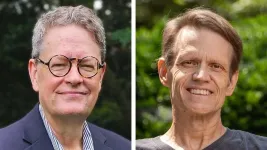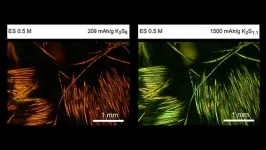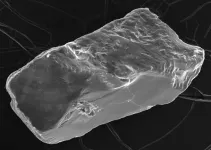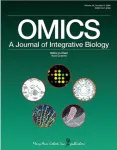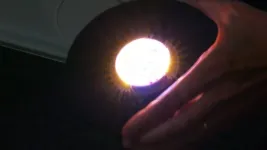(Press-News.org) A pair of physicists with long ties to PPPL are being honored for their foundational work on turbulence in plasma. Understanding why instabilities occur and how to limit them is critical to perfecting fusion as a stable energy source for the electrical grid.
Greg Hammett, a PPPL theoretical and computational principal research physicist, and Bill Dorland, former associate laboratory director for computational sciences and current Lab adviser, have won the 2024 James Clerk Maxwell Prize for Plasma Physics. The American Physical Society (APS) awards the $10,000 prize annually to recognize outstanding contributions to the field of plasma physics.
“Greg Hammett and Bill Dorland are world leaders in the development of theories and computer simulations regarding turbulence in confined plasmas. Their work has revolutionized high-power computer calculations for transport regarding plasma turbulence in both astrophysical plasma and in the magnetically confined plasmas we experiment with for fusion,” said Steve Cowley, PPPL’s Laboratory director and a longtime collaborator with Hammett and Dorland. “I am so pleased to see their hard work recognized by the APS.”
Their recognition follows in the footsteps of other PPPL legends, adding yet another chapter to the Lab’s storied legacy in plasma physics. The Maxwell Prize was first granted in 1975 to the Lab’s founder, Lyman Spitzer. Several other PPPL researchers have also won the award, including Amitava Bhattacharjee, Nat Fisch, Russell Kulsrud, and Masaaki Yamada.
“It’s an honor to get this award, and I hope it’s also seen as recognition of the excellent work by many people who have helped our field,” said Hammett. “When I started, most scientists in the field thought of turbulence in plasmas as an intractably hard problem. They’d say, ‘Don't even bother trying to understand it.’” However, with advances in the tools used to measure plasma parameters and computing power — and essential insights from Hammett and Dorland — came useful computer simulations that have grown better and better at simulating real-world behavior. Sophisticated computer simulations developed by them and others in the fusion community are harnessing the power of modern supercomputers to understand existing fusion experiments and search for ways to improve future fusion power plants.
Decades of work, dozens of papers
Hammett and Dorland’s decades of work — including more than 45 papers written together — goes all the way back to the early fluid approximations Dorland explored in his doctoral thesis when Hammett was his adviser. “Greg was my Ph.D. adviser, and I was his very first student. That’s why we’re tied together at the waist,” said Dorland.
Plasma turbulence can limit the maximum temperature in a fusion device and, thus, can limit how much fusion power it makes. Using a combination of analytical techniques and numerical methods to calculate rapid fluctuations in turbulence, the pair enabled research that would not have been possible without their work.
Turbulence is also a common phenomenon in nature, seen in the air moving around airplanes, fluids flowing through pipes and the eddies of water that form around ships, so it’s little surprise that Hammett and Dorland’s work has also inspired work in the astrophysics and solar wind research communities.
“We were very lucky to have such a brilliant pair ask the right set of questions from the start. It made it so much easier for those of us that came after. I simply cannot imagine where we would be without them. Probably 20 years behind!” said Felix Parra Diaz, head of PPPL’s Theory Department and nominator of Dorland and Hammett. “They were also extremely generous with the community, sharing their computational tools widely and helping with the analysis of experiments.”
Hammett: A child of the space race
Hammett says his interest in physics began in his youth when he watched news about the Apollo moon missions. Hammett’s father, a U.S. Air Force fighter pilot and hot-rodder, was always interested in “technical things” and fostered his love of the field. “Then we were in the middle of the first energy crisis, and fusion research seemed like a good way to combine physics interests into something that might be practical and useful,” he said.
Hammett came to PPPL in 1980 as a graduate student at Princeton University after earning a bachelor’s degree in physics from Harvard University. He has taught graduate courses for nearly 30 years, has been a lecturer with the rank of professor in the Princeton Program in Plasma Physics since 2001 and is an associated faculty member with the Program in Applied & Computational Mathematics at Princeton. An APS fellow, he has co-authored more than 225 papers, many highly cited.
Dorland: Filled with emotion
Despite the duo’s prolific authorship, Dorland said he was completely surprised when he was told they had won the Maxwell Prize. "I was filled with emotion and overwhelmed,” said Dorland. “I've just been walking on air since.”
Dorland was the founding head of the Computational Sciences Department at PPPL and continues to support its growing initiatives as a special adviser to Cowley. Dorland is a professor of physics at the University of Maryland and a member of Maryland’s Institute for Research in Electronics and Applied Physics. He is also a visiting professor of physics at the University of Oxford. He received a bachelor’s degree in physics from the University of Texas at Austin with special and highest honors and a doctoral degree in astrophysical sciences from Princeton University in 1993, as well as a master’s degree in public affairs from the Princeton School of Public and International Affairs, where he focused on science policy. Dorland won the 2009 Ernest Orlando Lawrence Award of the U.S. Department of Energy for his work on the theory and simulations of turbulence in fusion reactors, and he is a fellow of the APS.
Dorland has been highly committed to inspiring and mentoring students in plasma physics, particularly undergraduate students. He is a University of Maryland Marquee Courses in Science and Technology faculty member, part of the Merrill Presidential Scholars Program faculty and a University of Maryland Distinguished Scholar-Teacher. He served as the founding executive director of the university’s Honors College for seven years.
“Particularly important colleagues in our work have been Steve Cowley, Mike Kotschenreuther at the University of Texas at Austin, Ron Waltz and Jeff Candy at General Atomics, Alex Schekochihin at the University of Oxford, and Mike Beer (now a professor of biomedical engineering, genetic medicine and oncology at Johns Hopkins University) who was a Princeton graduate student in plasma physics and then a scientist at PPPL,” Hammett said.
Both also said they were fortunate to have families who encouraged their scientific pursuits. Hammett expressed his gratitude to his wife, Kate, for her continued encouragement and helping balance his life. Dorland also extended heartfelt thanks to his wife, Sarah, and their daughter, Kendall, for their unwavering support.
Hammett and Dorland will accept their award “for pioneering work in kinetic plasma turbulence that revolutionizes turbulent transport calculations for magnetic confinement devices and inspires research in astrophysical plasma turbulence” this October at the annual meeting of the APS’ Division of Plasma Physics in Atlanta.
END
Trailblazers in plasma turbulence computer simulations win 2024 James Clerk Maxwell Prize
Greg Hammett and Bill Dorland are recognized for groundbreaking contributions to plasma physics
2024-09-16
ELSE PRESS RELEASES FROM THIS DATE:
Technology could boost renewable energy storage
2024-09-16
Renewable energy sources like wind and solar are critical to sustaining our planet, but they come with a big challenge: they don't always generate power when it's needed. To make the most of them, we need efficient and affordable ways to store the energy they produce, so we have power even when the wind isn't blowing or the sun isn't shining.
Columbia Engineering material scientists have been focused on developing new kinds of batteries to transform how we store renewable energy. In a new study published September 5 by Nature Communications, the team used K-Na/S batteries that combine inexpensive, readily-found elements -- ...
Introducing SandAI: A tool for scanning sand grains that opens windows into recent time and the deep past
2024-09-16
Stanford researchers have developed an artificial intelligence-based tool – dubbed SandAI – that can reveal the history of quartz sand grains going back hundreds of millions of years. With SandAI, researchers can tell with high accuracy if wind, rivers, waves, or glacial movements shaped and deposited motes of sand.
The tool gives researchers a unique window into the past for geological and archeological studies, especially for eras and environments where few other clues, such as fossils, are preserved ...
Critical crops’ alternative way to succeed in heat and drought
2024-09-16
Scientists have discovered that certain plants can survive stressful, dry conditions by controlling water loss through their leaves without relying on their usual mechanism - tiny pores known as ‘stomata’.
Nonstomatal control of transpiration in maize, sorghum, and proso millet – all C4 crops which are critical for global food security – gives these plants an advantage in maintaining a beneficial microclimate for photosynthesis within their leaves.
This allows the plants to absorb carbon dioxide ...
Students with multiple marginalized identities face barriers to sports participation
2024-09-16
MINNEAPOLIS/ST. PAUL (09/16/2024) — The U.S. Department of Health and Human Services Healthy People 2030 plan sets a national objective to increase youth sports participation from 50% to 63% over the next five years. For adolescents, staying active offers benefits to their overall health and their social and academic lives. However, the number of youths participating in physical activity and sports is on the decline. While participation gaps based on single social identities ...
Purdue deep-learning innovation secures semiconductors against counterfeit chips
2024-09-16
WEST LAFAYETTE, Ind. — Researchers in Purdue University’s College of Engineering have developed a patent-pending optical counterfeit detection method for chips used in semiconductor devices.
The Purdue method is called RAPTOR, or residual attention-based processing of tampered optical responses. It leverages deep learning to identify tampering. It improves upon traditional methods, which face challenges in scalability and discriminating between natural degradation and adversarial tampering.
Alexander Kildishev, professor in the Elmore ...
Will digital health meet precision medicine? A new systematic review says it is about time
2024-09-16
A new systematic review of pharmacogenomics clinical decision support systems used in clinical practice in the peer-reviewed OMICS: A Journal of Integrative Biology suggests that these e-health tools can help accelerate pharmacogenomics, precision/personalized medicine, and digital health emergence in everyday clinical practice worldwide. Click here to read the article now.
Anastasia Farmaki, MSc, from the Centre for Research and Technology Hellas, Thessaloniki, and coauthors in Greece, conducted a systematic review that examined and mapped the pharmacogenomics-clinical decision support ...
Improving eye tracking to assess brain disorders
2024-09-16
A University of Houston engineering team has developed wearable sensors to examine eye movement to assess brain disorders or damage to the brain. Many brain diseases and problems show up as eye symptoms, often before other symptoms appear.
You see, eyes are not merely a window into the soul, as poets would have it. These incredibly precious organs are also an extension of the brain and can provide early warning signs of brain-related disorders and information on what causes them. Examining the eyes can also help track the progression and symptoms of physical and mental shocks to the brain.
Researchers say ...
Hebrew University’s professor Haitham Amal is among a large $17 million grant consortium for pioneering autism research
2024-09-16
Hebrew University of Jerusalem is proud to announce that Professor Haitham Amal is among a large $17M grant consortium for pioneering autism research. This grant is part of an American funding initiative awarded by the California Institute for Regenerative Medicine (CIRM), aimed at advancing cutting-edge autism studies.
A world-renowned expert in nitric oxide and brain disorders, Professor Amal has made groundbreaking discoveries in autism research. His team was the first to identify a direct link between nitric oxide levels in the brain and autism spectrum disorder (ASD), a finding with profound implications for the ...
Scientists mix sky’s splendid hues to reset circadian clocks
2024-09-16
Those mesmerizing blue and orange hues in the sky at the start and end of a sunny day might have an essential role in setting humans’ internal clocks.
In new research from the University of Washington in Seattle, a novel LED light that emits alternating wavelengths of orange and blue outpaced two other light devices in advancing melatonin levels in a small group of study participants.
Published in the Journal of Biological Rhythms, the finding appears to establish a new benchmark in humans’ ability to influence their circadian rhythms, and reflects an effective new approach to counteract seasonal affective disorder (SAD).
A ...
Society for Neuroscience 2024 Outstanding Career and Research Achievements
2024-09-16
Embargoed until Monday, September 16, noon EDT Contact: development@sfn.org
CHICAGO – The Society of Neuroscience (SfN) will honor leading researchers whose groundbreaking work has transformed neuroscience — including the understanding of pain, addiction, stress, synaptic transport, vision, and sleep — with this year’s Outstanding Career and Research Achievement Awards. The awards will be presented during SfN’s annual ...
LAST 30 PRESS RELEASES:
Victoria’s Secret grant backs cutting-edge ovarian cancer research
Research paves the way for safer colonoscopy bowel prep for people with compromised gut health
JMIR Publications and Sweden's National Library announce renewal and expansion of flat-fee unlimited open access partnership for 2026
A new 3D-printed solar cell that’s transparent and color-tunable
IV iron is the cost-effective treatment for women with iron deficiency anemia and heavy menstrual bleeding
Doing good pays off: Environmentally and socially responsible companies drive value and market efficiency
City of Hope and Cellares to automate manufacturing of solid tumor CAR T cell therapy
Short-circuiting pancreatic cancer
Groundbreaking mapping: how many ghost particles all the Milky Way’s stars send towards Earth
JBNU researchers propose hierarchical porous copper nanosheet-based triboelectric nanogenerators
A high-protein diet can defeat cholera infection
A more accurate way of calculating the value of a healthy year of life
What causes some people’s gut microbes to produce high alcohol levels?
Global study reveals widespread burning of plastic for heating and cooking
MIT study shows pills that communicate from the stomach could improve medication adherence
Searching for the centromere: diversity in pathways key for cell division
Behind nature’s blueprints
Researchers search for why some people’s gut microbes produce high alcohol levels
Researchers find promising new way to boost the immune response to cancer
Coffee as a staining agent substitute in electron microscopy
Revealing the diversity of olfactory receptors in hagfish and its implications for early vertebrate evolution
Development of an ultrasonic sensor capable of cuffless, non-invasive blood pressure measurement
Longer treatment with medications for opioid use disorder is associated with greater probability of survival
Strategy over morality can help conservation campaigns reduce ivory demand, research shows
Rising temperatures reshape microbial carbon cycling during animal carcass decomposition in water
Achieving ultra-low-power explosive jumps via locust bio-hybrid muscle actuators
Plant-derived phenolic acids revive the power of tetracycline against drug-resistant bacteria
Cooperation: A costly affair in bacterial social behaviour?
Viruses in wastewater: Silent drivers of pollution removal and antibiotic resistance
Sub-iethal water disinfection may accelerate the spread of antibiotic resistance
[Press-News.org] Trailblazers in plasma turbulence computer simulations win 2024 James Clerk Maxwell PrizeGreg Hammett and Bill Dorland are recognized for groundbreaking contributions to plasma physics
